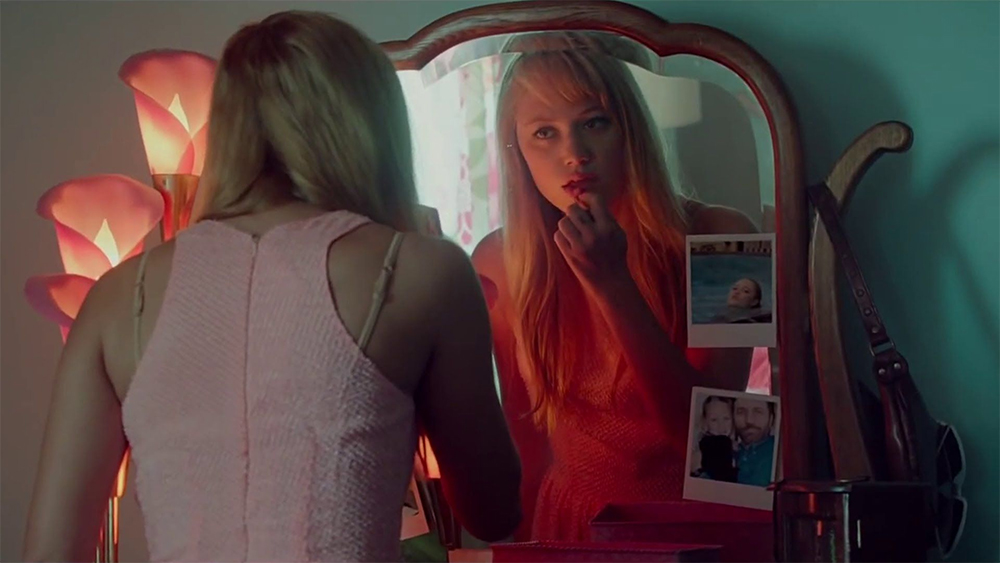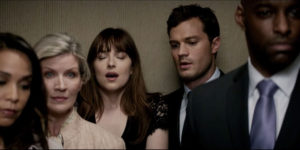
High heels on concrete. A girl races from her front door to the street before circling back on herself and speeding away in the family car. What she’s running from, we don’t know. Throughout all of this the camera rotates on the spot, constantly keeping the girl in frame as she completes her circuit. We don’t know this yet, but we’ve just undertaken a death waltz. In a few minutes time, the girl will be dead. And so begins David Robert Mitchell’s sublime new horror movie It Follows. Already arriving with blazing trail of praise from the festival circuit, it is undoubtedly one of the most striking chillers from the past few years. Like many of his contemporaries, Mitchell expertly mines stylistic tropes of the past in order to present us with a new vision of terror. But one has to ask: is the current trend of throwback horror becoming a bit tired?
Following the stage-setting prologue, the film zeroes in on your typical movie teenager Jay (Maika Monroe). She drifts through lessons at school, talks shit with her friends and plans dates with her boyfriend, Hugh. After finally going to the full nine yards with him in the backseat of his car, Jay is met with a dose of chloroform and wakes to find herself tied to a wheelchair in an abandoned building. Hugh explains that she is now infected with a curse that makes her the target of a murderous entity which will stalk her in various forms until it kills her. If she dies, the curse reverts back to Hugh, then to the person who infected him and so on and so forth. The only way to escape is by passing the curse on to somebody else via sexual intercourse.
Now if there’s one thing horror movies have taught us over the past five decades, it’s that sex is bad, mkay. With that in mind it’s surprising how few horror films actually take sex and make it a real physical threat as opposed to just a harbinger of doom. Cronenberg made it his bread and butter with films like Shivers and Rabid and cartoonist Charles Burns turned it into a classic graphic novel called Black Hole. There’s probably even a version of this movie bubbling away in Eli Roth’s imagination that’s similar to the orgy sequence in Eyes Wide Shut just with Fake Shemps from The Evil Dead instead of super models. Now that film would have it’s own pleasures no doubt but I can’t imagine they would come close to the majesty of Mitchell’s simplistic approach. This is more like watching Sofia Coppola direct Teeth. It Follows never sensationalizes its concept and is instead a movie full of empty frames and threat-laden backgrounds. The entity stalking Jay appears to her in the form of slow-moving human avatars. It can be a stranger – a naked guy on a roof, for example – or someone more familiar, like her Dad. Whenever Jay strolls into a new environment, our eyes can’t help but scan the surroundings for any ominous looking silhouettes or approaching figures. It’s a nifty trick and one that keeps the audience alert and vulnerable. Most importantly, it ensures that this is a horror film about the uncertainty of space. It’s very rare that you feel safe while watching It Follows, just like Jay you can never get comfortable in any one scene. The movie might be paced like a European art film but there’s an uneasiness bubbling beneath which makes it absolutely gripping.
We now seem to be in the throws of a resurgence in restrained terror and the world of It Follows is an aesthetic dreamland. Like pretty much every other horror filmmaker who grew up in the 80s, Mitchell cherry picks the cinematic language of John Carpenter and filters it through a contemporary lens. Entertainment Weekly named Carpenter the most influential director of 2014 due to the recent influx of genre movies built from his stylistic DNA. What a time to be alive! But some of these movies can rely on Carpenter’s shadow too much and run the risk of not having anything original to say. Thankfully Mitchell avoids that pitfall for the most part and has made what will probably be regarded as the crowning jewel of this decade’s Carpenter knock-offs. Following in the footsteps of Adam Wingard, Ti West and Jim Mickle, he uses the widest lens possible and relies much more on atmosphere and suggestion for shocks rather than the aggressive maximalism ushered in by the torture porn crowd. Not only does he nail Carpenter’s visual sensibilities, the film’s sonic design is ear-splittingly good. Scored by video game veteran Disasterpeace, the soundtrack is all bubbling synths and electronic shards. The film stabs at you aurally and amounts to one of the most impressive soundscapes I’ve heard recently. It certainly owes a great debt to Carpenter but satisfyingly launches his sound into thrilling new territory.
That being said, Mitchell’s hat-tipping often makes It Follows feel like a film lost in time. We’re never explicitly told when the action takes place but judging from the technology on show it appears to be present day. Yet, the characters are constantly watching old scratchy B-movies on 4:3 TV sets and there is nary a whiff of a pop-culture reference or car that wouldn’t be out of place in the 1980s. We have to assume this is a universe set in a timeline of Mitchell’s own creation as I’m pretty sure kids don’t go on first dates to watch Charade anymore. It’s probably a film best enjoyed by horror-literate cinephiles rather than contemporary teenage moviegoers as I can’t imagine they’d find much to relate to in the youth Mitchell depicts. Jay is the only character given any sort of substance. The kids around her are never developed to a satisfying degree. Monroe does a terrific job of carrying the film on her shoulders (this and last year’s The Guest make her something of a modern-day scream queen) but more is needed to grab the audience hook, line and sinker.
Unlike recent genre throwbacks like The Babadook and You’re Next, It Follows struggles to scratch deeper into it’s characters’ skin and actually immerse us into a psyche or visceral funhouse. It’s a stunning film to observe and run your fingertips across but not one you can totally get lost inside of. Mitchell succeeds in making a horror film ripe with aesthetic pleasures – it looks and sounds like pure art – but he fails at making a rollicking crowd pleaser that modern audiences can really connect to. How big a problem this is totally depends on your tastes as a moviegoer. James Wan proved with Insidious (underrated) and The Conjuring (overrated) that it’s possible to make nostalgic horror films that also appeal to the mainstream. Their sensibilities are world’s apart of course but I wonder how successful the throwback approach to horror films really is if the movies themselves aren’t scaring the pants off of their audiences.
It Follows is a great film and extremely accomplished, so much so that I wouldn’t be surprised to see it crop up on many genre lovers’ “Best of” lists twelve months from now. For those averse in the language and history of the genre, it’s a rewarding exercise in retro-styling and B-movie chic but casual viewers looking for more bracing, visceral chills will probably want more meat on the bone.
—
Directed by David Robert Mitchell; written by David Robert Mitchell; starring Maika Monroe, Keir Gilchrist, Daniel Zovatto, Jake Weary, Olivia Luccardi, Lili Sepe; 100 minutes.
It Follows is in cinemas now.



 Derek
Derek
 Isabelle
Isabelle